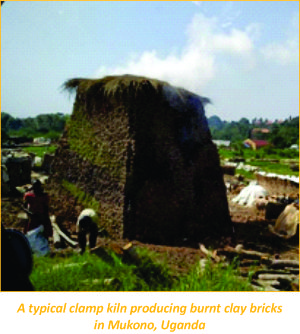Greening the Brick Sector in Uganda
Uganda
is one of the Least Developed Countries (LDCs) in East Africa. This
country’s priority is to reduce the vulnerability of its population,
environment and economy by implementing adaptation actions. Major challenges
for the country today are ideological disorientation, weak private sector,
underdeveloped human resourc es,
inadequate infrastructure, small market, lack of industrialisation,
underdeveloped service sector, underdeveloped agriculture and poor
democracy. The country has documented its vision for 2040 that identifies
key core projects in the areas of infrastructure, irrigation, metal
industry, transportation, energy, skills, science and technology etc. Uganda
intends to follow a climate-resilient and low-carbon development path linked
to green growth and broader sustainable development goals in the long term.
For this, the country needs quality building materials, improved processes
and practices and decent jobs. The brick sector in Uganda needs improvements
in terms of market demand and quality.
es,
inadequate infrastructure, small market, lack of industrialisation,
underdeveloped service sector, underdeveloped agriculture and poor
democracy. The country has documented its vision for 2040 that identifies
key core projects in the areas of infrastructure, irrigation, metal
industry, transportation, energy, skills, science and technology etc. Uganda
intends to follow a climate-resilient and low-carbon development path linked
to green growth and broader sustainable development goals in the long term.
For this, the country needs quality building materials, improved processes
and practices and decent jobs. The brick sector in Uganda needs improvements
in terms of market demand and quality.
The brick sector is unorganised and very few manufacturers are producing fired clay bricks including Uganda Clays Limited, Kowotto Clays Limited, Kampala. Most of the population cannot afford the quality bricks due to limited supply and high costs. Thus, a practice to produce semi-fired poor quality bricks with random sizes using traditional clamp kilns exists. The environmental problems in the brick industry have been exacerbated by access to valuable resources of high quality logs transported over increasingly long distances. Uninterrupted use of these resources will result in environmental damage in terms of deforestation, continued wastage of energy and high air pollution. Working conditions in existing brick kilns in Uganda are unhealthy and unsafe. All operations are weather dependent. As a result, all clamp kilns in the country remain un-operational during the wet rainy season.
The bricks are being hand moulded resulting in different sizes of bricks being produced. It is an extremely slow process. The quality of bricks produced in clamp kilns is not uniform and are usually of very poor quality. These bricks find their application in constructing only single story buildings due to their low strength. Therefore, there is an immediate need of transforming the entire brick sector in the country.
In light of the South- South Cooperation interventions, TARA, the social enterprise wing of the Development Alternatives Group has partnered with StanBrick Factory Limited, a Kampala based Ugandan start-up to transform the existing practices in the brick sector. TARA has offered its services to support StanBricks in the implementation of the most energy efficient EcoKiln technology in Uganda. As a phase wise strategy, an initial pre-feasibility assessment was conducted to understand availability of appropriate soil, waste biomass and ash for brick production using EcoKiln technology. During the study, a variety of biomass wastes from sugarcane, brewery, timber and agro industries were found as potential firing sources. Variety of soil samples were also tested from multiple sources for their use as a feed for green brick moulding.
Introduction of EcoKiln will demonstrate production of quality bricks at reduced cost, bring resource efficiency in terms of fuel consumption, secure decent jobs through improved practices and operations in brick manufacturing and help in the transition of the country to a low carbon economy. ■
Dr. Ankur Sarswat
asarswat@devalt.org